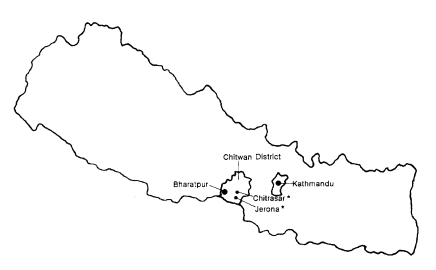Nepal is a Himalayan kingdom located between China and India. The climate varies from cool summers and severe winters in the north to subtropical summers and mild winters in the south. Over 85% of 21.9 million population are engaged in agriculture and the life expectancy at birth is 54 years. Population growth rate is 2.6%, and literacy rate is 28% of a total population. Agricultural products are rice, millet, corn, wheat, sugar cane and root corps etc. Live stock and live stock products are cattle, buffalo, goat, milk and meat etc. (Bacon et al., 1997; Rai et al., 1998).
Like other developing countries, intestinal parasite infections are major health problems in Nepal. Epidemiological surveys on the intestinal parasite infections are important in this country because they reflect sanitary conditions of the community and produce basic data for the control of parasitosis in the future.
Bharatpur is a city located in western part of Chitwan District and about 146 km southwest of Kathmandu, the capital of Nepal. Chitrasar and Jerona are villages in agricultural area in Chitwan District located about 12 km east and southeast of Bharatpur, respectively (Fig. 1). A total of 300 stool specimens was collected from elementary schoolchildren in November, 1999. The stools were examined by microscopy following formalin-ether sedimentation technique.
The prevalence rate of intestinal parasite infections of schoolchildren in Jerona and Chitrasar were 48.8% and 37.9%, respectively (Table 1). The prevalence rate was slightly higher in females (46.3%) than that in males (42.1%) without statistically significant difference. Slightly higher prevalence rates of intestinal parasite infections in females have been reported in Nepal previously (Rai et al., 1994; Rai et al., 1998).
The cyst positive rate of intestinal protozoa infections were 21.0%, 13.7%, 3.7%, 2.3% and 0.3% for Entamoeba coli, Giardia lamblia, Entamoeba histolytica/Entamoeba dispar, Endolimax nana and Iodamoeba buetchilii, respectively (Table 2). The egg positive rate of helminth infections were 13.0%, 3.0%, 1.7%, 1.7% and 1.3% for hookworm, Trichuris trichiura, Ascaris lumbricoides, Hymenolepis nana and Fasciola hepatica, respectively. Three pinworm egg positive cases were found out of 300 examines (1%) on stool examination, suggesting high prevalence of pinworm infections in schoolchildren. The prevalence rate of each intestinal parasite infection in Jerona was higher than that in Chitrasar except G. lamblia (Table 2). F. hepatica eggs were detected without confirmation of true infection. No other trematode eggs were found on stool examinations. Interestingly, the prevalence rate of protozoan parasite infections was relatively higher than that of helminth infections in this survey, suggesting problems in their drinking water.
Several previous studies showed that A. lumbricoides was the most common helminth in Nepal (Rai et al., 1994; Rai et al., 1997; Rai et al., 1998). Other studies showed that hookworm was the most common helminth in Nepal (Navitsky et al., 1983; Estevez et al., 1998), as same as in this study. Different surveyed areas would be the reason for the difference. Hookworm infection is recognized as an important contributor to iron-deficiency anemia in populations with poor diets (Stolzfus et al., 1997; Albonico et al., 1998). Hookworm infects humans through penetration of the skin. The residents have no footwear or wear thong-type sandals, so hookworms easily penetrate the skin, especially in sandy conditions. Hookworm infection rate was reported higher in the monsoon season (June-September) than in the remaining dry months of the year in Nepal (Navitsky et al., 1998). Forty-three specimens (14.3%) showed mixed infections from 2 to 4 parasite species (Table 3). The rate of mixed parasite infections in Nepal has been reported as high as 87.5% (Estevez et al., 1983).
High prevalence rate of intestinal parasite infections is associated with intake of contaminated water, open defecation habit, poor hygiene and poor sanitary conditions etc. Relatively simple personal protections, such as personal hygiene, appropriate water management (boiling), use of latrines and improvement in footwear contribute to prevent parasite infections. School-based anthelminthic chemotherapy is also a cost-effective approach for controlling intestinal helminth infections (Albonico et al., 1999).
In conclusion, high prevalence rate of intestinal parasite infections were found in two rural villages in Nepal, and it is necessary to implement large-scale treatment with anthelminthics, health education and sanitary improvement for intestinal parasite control in the areas.




